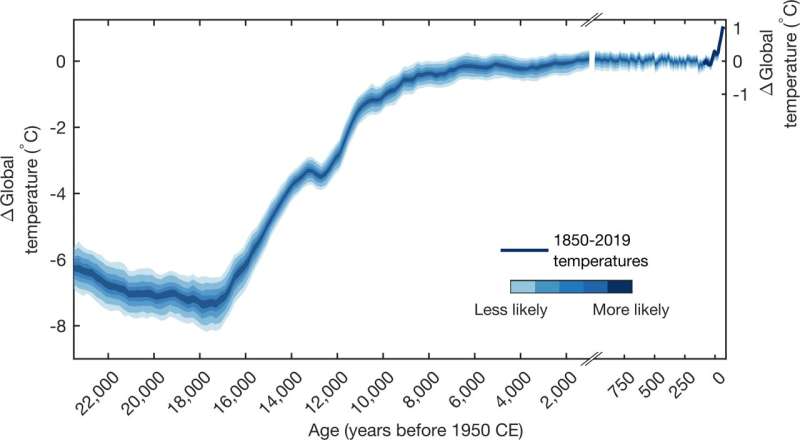Global temperatures over last 24,000 years show today's warming 'unprecedented'

A University of Arizona-led effort to reconstruct Earth's climate since the last ice age, about 24,000 years ago, highlights the main drivers of climate change and how far out of bounds human activity has pushed the climate system.
The study, published this week in Nature, had three main findings:
- It verified that the main drivers of climate change since the last ice age are rising greenhouse gas concentrations and the retreat of the ice sheets.
- It suggests a general warming trend over the last 10,000 years, settling a decade-long debate about whether this period trended warmer or cooler in the paleoclimatology community.
- The magnitude and rate warming over the last 150 years far surpasses the magnitude and rate of changes over the last 24,000 years.
"This reconstruction suggests that current temperatures are unprecedented in 24,000 years, and also suggests that the speed of human-caused global warming is faster than anything we've seen in that same time," said Jessica Tierney, a UArizona geosciences associate professor and co-author of the study.
Tierney, who heads the lab in which this research was conducted, is also known for her contributions to the Intergovernmental Panel on Climate Change reports and climate briefings for the U.S. Congress.

"The fact that we're today so far out of bounds of what we might consider normal is cause for alarm and should be surprising to everybody," said lead study author Matthew Osman, a geosciences postdoctoral researcher at UArizona.
An online search of "global temperature change since the last ice age" would produce a graph of global temperature change over time that was created eight years ago.

"Our team's reconstruction improves on that curve by adding a spatial dimension," Tierney said.
The team created maps of global temperature changes for every 200-year interval going back 24,000 years.
"These maps are really powerful," Osman said. "With them, it's possible for anyone to explore how temperatures have changed across Earth, on a very personal level. For me, being able to visualize the 24,000-year evolution of temperatures at the exact location I'm sitting today, or where I grew up, really helped ingrain a sense of just how severe climate change is today."
There are different methods for reconstructing past temperatures. The team combined two independent datasets—temperature data from marine sediments and computer simulations of climate—to create a more complete picture of the past.
The researchers looked at the chemical signatures of marine sediments to get information about past temperatures. Because temperature changes over time can affect the chemistry of a long-dead animal's shell, paleoclimatologists can use those measurements to estimate temperature in an area. It's not a perfect thermometer, but it's a starting point.
Computer-simulated climate models, on the other hand, provide temperature information based on scientists' best understanding of the physics of the climate system, which also isn't perfect.
The team decided to combine the methods to harness the strengths of each. This is called data assimilation and is also commonly used in weather forecasting.
"To forecast the weather, meteorologists start with a model that reflects current weather, then add in observations such as temperature, pressure, humidity, wind direction, and so on to create an updated forecast," Tierney said.
The team applied this same idea to past climate.
"With this method, we are able to leverage the relative merits of each of these unique datasets to generate observationally constrained, dynamically consistent and spatially complete reconstructions of past climate change," Osman said.
Now, the team is working on using their method to investigate climate changes even farther in the past.
"We're excited to apply this approach to ancient climates that were warmer than today," Tierney said, "because these times are essentially windows into our future as greenhouse gas emissions rise."
More information: Matthew Osman, Globally resolved surface temperatures since the Last Glacial Maximum, Nature (2021). DOI: 10.1038/s41586-021-03984-4. www.nature.com/articles/s41586-021-03984-4
Journal information: Nature
Provided by University of Arizona





















